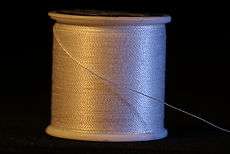Mercerised cotton


Mercerisation is a treatment for cellulosic material, typically cotton threads, that strengthens them and gives them a lustrous appearance. The process is less frequently used for linen and hemp threads.
Development
The process was devised in 1844 by John Mercer of Great Harwood, Lancashire, England, who treated cotton fibres with sodium hydroxide. The treatment caused the fibers to swell, which in Mercer's version of the process shrank the overall fabric size and made it stronger and easier to dye. The process did not become popular until H. A. Lowe improved it into its modern form in 1890. By holding the cotton during treatment to prevent it from shrinking, Lowe found that the fibre gained a lustrous appearance.[1][2] The process was taken to the DMC company in Mulhouse, France by Jean Dollfus in the 19th century.[3]
Process
Mercerisation alters the chemical structure of the cotton fibre. The structure of the fibre inter-converts from an alpha- and beta-cellulose mixture to a thermodynamically favourable cellulose II polymorph.[4] Mercerising results in the swelling of the cell wall of the cotton fibre. This causes an increase in the surface area and reflectance, and gives the fibre a softer feel.[5] An optional last step in the process is passing the thread over an open flame, or singeing. This incinerates stray fibers, improving the fabric's appearance. This is known as "gassing the thread" because of the gas burner that is typically used.
Thread
The modern production method for mercerised cotton, also known as "pearl" or "pearle" cotton, gives cotton thread (or cotton-covered thread with a polyester core) a sodium hydroxide bath that is then neutralized with an acid bath. This treatment increases lustre, strength, affinity to dye, and resistance to mildew. On the other hand, it also increases its affinity to lint.
Cotton with long staple fibre lengths responds best to mercerisation. Mercerised thread is commonly used to produce fine crochet.
References
- ↑ J. Gordon Cook (1984). Handbook of Textile Fibres: Volume I: Natural Fibres. Woodhead. p. 68. ISBN 1-85573-484-2.
- ↑ Beaudet, Tom (1999). "What is Mercerized cotton?". FiberArts.org. Retrieved 2007-01-03.
- ↑ DMC History, DMCCreative, retrieved 29 October 2014
- ↑ P. Zugenmaier (2008). Crystalline cellulose and cellulose derivatives : characterization and structures. Springer. ISBN 9783540739333.
- ↑ Textile Technology: Cotton/Kenaf Fabrics: a Viable Natural Fabric, P. Bel-Berger, et al. Journal of Cotton Science, 3:60–70 (1999). "Cotton/kenaf fabrics can be further improved in softness and "hand" (the feel of textiles when handled). The effects of different fabric treatments such as enzymes, bleaching, and mercerization were compared and measured for softness of hand. Two types of fabrics were treated, a lightweight plain weave and a heavyweight twill. Mercerization dramatically improved the softness and hand for both fabrics."


.svg.png)